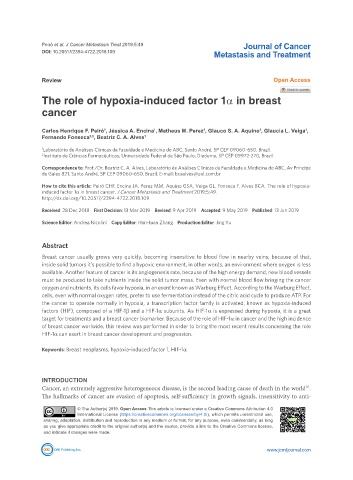Page 692 - Read Online
P. 692
Peiró et al. J Cancer Metastasis Treat 2019;5:49 Journal of Cancer
DOI: 10.20517/2394-4722.2018.109 Metastasis and Treatment
Review Open Access
The role of hypoxia-induced factor 1α in breast
cancer
Carlos Henrique F. Peiró , Jéssica A. Encina , Matheus M. Perez , Glauco S. A. Aquino , Glaucia L. Veiga ,
1
1
1
1
1
Fernando Fonseca , Beatriz C. A. Alves 1
1,2
1 Laboratório de Análises Clínicas da Faculdade e Medicina do ABC, Santo André, SP CEP 09060-650, Brazil.
2 Instituto de Ciências Farmacêuticas, Universidade Federal de São Paulo, Diadema, SP CEP 09972-270, Brazil.
Correspondence to: Prof./Dr. Beatriz C. A. Alves, Laboratório de Análises Clínicas da Faculdade e Medicina do ABC, Av Príncipe
de Gales 821, Santo André, SP CEP 09060-650, Brazil. E-mail: bcaalves@uol.com.br
How to cite this article: Peiró CHF, Encina JA, Perez MM, Aquino GSA, Veiga GL, Fonseca F, Alves BCA. The role of hypoxia-
induced factor 1α in breast cancer. J Cancer Metastasis and Treatment 2019;5:49.
http://dx.doi.org/10.20517/2394-4722.2018.109
Received: 28 Dec 2018 First Decision: 13 Mar 2019 Revised: 9 Apr 2019 Accepted: 9 May 2019 Published: 13 Jun 2019
Science Editor: Andrea Nicolini Copy Editor: Han-Juan Zhang Production Editor: Jing Yu
Abstract
Breast cancer usually grows very quickly, becoming insensitive to blood flow in nearby veins; because of that,
inside solid tumors it’s possible to find a hypoxic environment, in other words, an environment where oxygen is less
available. Another feature of cancer is its angiogenesis rate, because of the high energy demand, new blood vessels
must be produced to take nutrients inside the solid tumor mass. Even with normal blood flow bringing the cancer
oxygen and nutrients, its cells favor hypoxia, in an event known as Warburg Effect. According to the Warburg Effect,
cells, even with normal oxygen rates, prefer to use fermentation instead of the citric acid cycle to produce ATP. For
the cancer to operate normally in hypoxia, a transcription factor family is activated, known as hypoxia-induced
factors (HIF), composed of a HIF-1β and a HIF-1α subunits. As HIF-1α is expressed during hypoxia, it is a great
target for treatments and a breast cancer biomarker. Because of the role of HIF-1α in cancer and the high incidence
of breast cancer worlwide, this review was performed in order to bring the most recent results concerning the role
HIF-1α can exert in breast cancer development and progression.
Keywords: Breast neoplasms, hypoxia-induced factor 1, HIF-1α
INTRODUCTION
Cancer, an extremely aggressive heterogeneous disease, is the second leading cause of death in the world .
[1]
The hallmarks of cancer are evasion of apoptosis, self-sufficiency in growth signals, insensitivity to anti-
© The Author(s) 2019. Open Access This article is licensed under a Creative Commons Attribution 4.0
International License (https://creativecommons.org/licenses/by/4.0/), which permits unrestricted use,
sharing, adaptation, distribution and reproduction in any medium or format, for any purpose, even commercially, as long
as you give appropriate credit to the original author(s) and the source, provide a link to the Creative Commons license,
and indicate if changes were made.
www.jcmtjournal.com

